|
Fed holds rates steady
|
 |
June 28, 2000: 5:23 p.m. ET
Leaves fed funds rate at 6.5%, but warns about inflationary pressures
By Staff Writer M. Corey Goldman
|
NEW YORK (CNNfn) - Federal Reserve policy makers opted to hold the line on interest rates Wednesday, but issued a warning to both Wall Street and Main Street that it remains on high alert for signs of accelerating inflation -- something that could lead them to raise rates again down the road.
In a widely expected move, the Federal Open Market Committee left its influential fed funds target for overnight loans between banks at 6.5 percent. It also left the discount rate -- the rate at which the Fed's 12 district banks lend directly to financial institutions -- at 6 percent.
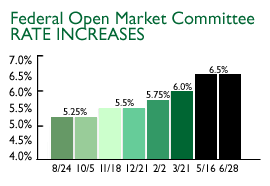 In the briefly worded statement that accompanied the Fed's decision, the FOMC said that "continuing rapid advances in productivity have been containing costs and holding down underlying price pressures." At the same time, Fed officials said they believe that "the risks continue to be weighted mainly toward conditions that may generate heightened inflation pressures in the foreseeable future" -- a sign that it may not quite be finished raising rates. In the briefly worded statement that accompanied the Fed's decision, the FOMC said that "continuing rapid advances in productivity have been containing costs and holding down underlying price pressures." At the same time, Fed officials said they believe that "the risks continue to be weighted mainly toward conditions that may generate heightened inflation pressures in the foreseeable future" -- a sign that it may not quite be finished raising rates.
"What the Fed told us today is that the risks are still tilted toward inflation, but they're willing to wait and see if the slowdown is real," said Doug Porter, a senior economist with brokerage BMO Nesbitt Burns Inc. "What matters now is how the data unfolds in the months ahead."
Tentative signs of slowing
For consumers, the Fed's decision means that, at least for now, they'll get a reprieve from rising rates on credit cards and loans. The Fed has raised rates six times since June 1999 in the hopes of making consumers think twice about charging that expensive meal or buying that new computer. The same goes for companies, which will have the same borrowing costs, for now.
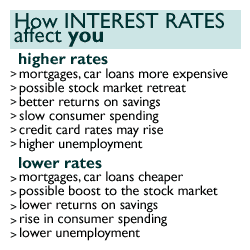 Stocks initially extended gains after the Fed's decision was made public shortly after 2 p.m. ET, as investors concluded that the Fed may be close to completing its yearlong rate hike binge. Both the Dow Jones industrial average and the Nasdaq composite index posted triple-digit advances shortly after the decision was announced. They both pared gains later in the day. Bonds recouped some of their losses, though they remained mostly lower on expectations that more rate increases may be in store. Stocks initially extended gains after the Fed's decision was made public shortly after 2 p.m. ET, as investors concluded that the Fed may be close to completing its yearlong rate hike binge. Both the Dow Jones industrial average and the Nasdaq composite index posted triple-digit advances shortly after the decision was announced. They both pared gains later in the day. Bonds recouped some of their losses, though they remained mostly lower on expectations that more rate increases may be in store.
The "on hold" decision comes amid a recent string of economic reports collectively suggesting that the U.S. economy is slowing. Private-sector job creation posted its first monthly drop in more than two years last month. Home sales retreated. Retail sales fell back. Manufacturing activity slowed, personal spending took a breather and the personal savings rate gained. Even consumer confidence has edged down to some extent.
Nonetheless, while the Fed's announcement was greeted with relief, analysts were quick to caution that it's not time to break out the champagne just yet. The economy has begun to exhibit signs of slowing since the Fed's last half-point hike in mid-May, but most analysts agree that much more evidence is needed before concluding that the economy is officially gearing down.
Treading very cautiously
"What the Fed told us today is, we don't think we are done yet and we are not sure when we will be done," said Diane Swonk, chief economist with Banc One. Until more evidence appears that the economy is responding to previous rate increases, the Fed will remain on alert, she said. Fed officials next meet August 22nd.
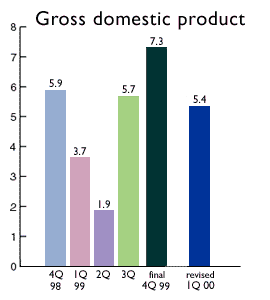 Most market participants are still betting on an August rate rise. The implied yield on the September fed fund futures contract, which gauges investor expectations about where the fed funds rate will be, is currently at 6.72 percent, almost a quarter-point higher than the current 6.5 percent fed funds rate, suggesting most see a quarter-point increase in August. Most market participants are still betting on an August rate rise. The implied yield on the September fed fund futures contract, which gauges investor expectations about where the fed funds rate will be, is currently at 6.72 percent, almost a quarter-point higher than the current 6.5 percent fed funds rate, suggesting most see a quarter-point increase in August.
What has both Wall Street and Main Street treading cautiously is the idea that recent evidence of an economic slowdown is only temporary, and that resilient consumer spending, a still-hot housing market, rebounding stock market values and the ongoing lack of skilled workers could lead to a pickup in activity in the second half of the year -- and more tough medicine from Fed.
On the flip side, rising energy costs, especially for retail gasoline, are expected to push up consumer prices in the months ahead, and many economists say the Labor Department's June employment report, due for release on July 7, could show a strong rebound from May's steep and somewhat suspicious job losses.
On alert for inflation
What's more, the days of unfounded gains in technology stocks - gains that fueled much discussion from Fed Chairman Alan Greenspan and others about stock market excesses and the wealth effect it was generating within the economy -- are now all but gone. For the year to date, the tech-heavy Nasdaq composite index is down 4 percent; the index rose a record 85.6 percent in 1999.
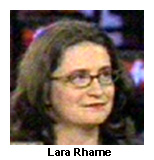 "They still do see a risk for heightened inflation pressures, so they cuffed it, as they typically do," said Mary Jo English, a portfolio manager with David L. Babson & Co. in Boston. "But they do seem to think that growth is slowing and ... demand may be moderating close to the economy's potential." "They still do see a risk for heightened inflation pressures, so they cuffed it, as they typically do," said Mary Jo English, a portfolio manager with David L. Babson & Co. in Boston. "But they do seem to think that growth is slowing and ... demand may be moderating close to the economy's potential."
The economy expanded at a 5.4 percent pace in the first quarter and is expected to slow a 3.7 percent pace in the second, according to a poll of economists conducted by Standard & Poor's MMS.
Lara Rhame, an economist with Brown Brothers Harriman, told CNNfn that the Fed's "warning message" -- that it is on alert for heightened inflation pressures -- reflects its concern with the nation's still-tight labor market; a situation that still threatens to boost wages and salaries, spurring higher prices for consumer goods and services. (377KB WAV) (377KB AIFF)
The Labor Department reported that some 116,000 private-sector jobs were lost last month. But there is still plenty of anecdotal evidence that the U.S. labor market remains hot, and that employers may have to start paying their workers higher wages and benefits in order to keep them on the payroll.
Desperately wanted: skilled workers
And that's if they can get the workers at all. At Madison Square Garden in Manhattan on Wednesday, employers assembled at Hotjobs.com Ltd. (HOTJ: Research, Estimates)'s Workworld conference in a seemingly feeble attempt to recruit new workers for technology-related positions.
"It's a great place to be if you're looking for a job, but not if you're actually looking for workers," said Josh Leeman, who attended the conference looking for professionals to help get his soon-to-be-funded business-to-business Web site up and running.
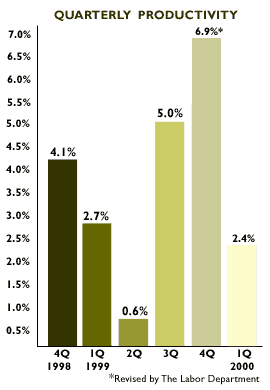 To be sure, productivity is one of the reasons the U.S. economy has been able to expand for an unprecedented 111 months without triggering an increase in consumer prices. Advances in technology have allowed companies to raise their per-worker output while containing wage costs, which would traditionally be passed on to consumers in the form of higher prices. To be sure, productivity is one of the reasons the U.S. economy has been able to expand for an unprecedented 111 months without triggering an increase in consumer prices. Advances in technology have allowed companies to raise their per-worker output while containing wage costs, which would traditionally be passed on to consumers in the form of higher prices.
Fed officials alluded to those gains in productivity Wednesday, suggesting that "continuing rapid advances in productivity have been containing costs and holding down underlying price pressures."
No doubt, there is lots of evidence out there that prices remain in check, analysts say. Ford Motor Co. (F: Research, Estimates), for instance, announced last week that it plans to hold the brakes on all prices for its 2001 model-year vehicles -- an unprecedented move in light of the fact that its sales are at record levels.
The reason Ford is able to do that is because of productivity, where technological advancements, including faster assembly, just-in-time delivery, and the exchange of parts and other information through the Web have allowed the automaker to keep its costs, and therefore prices, contained.
Back to the numbers
"Only a few years ago, auto sales numbers, like those seen recently, would have automatically lead to expectations of higher prices," said Ian Shepherdson, chief U.S. economist with High Frequency Economics. "Now, increasing transparency in car prices, substantially due to the Internet, together with the automakers' ability to hold down unit labor costs, means that stronger sales do not necessarily lead to higher prices."
 Between now and the next Fed policy meeting, Wall Street will closely watch the numerous reports on the state of the economy, most notably numbers on employment, consumer prices and manufacturing. Between now and the next Fed policy meeting, Wall Street will closely watch the numerous reports on the state of the economy, most notably numbers on employment, consumer prices and manufacturing.
Analysts admit that there are anecdotal signs that things are starting to cool off. Dot.com companies, for instance, have begun firing workers in the face of growing pressure to turn a profit, and sales of luxury items such as cars and vacations are beginning to taper off. Retail sales have declined for two consecutive months, and sales of durable goods -- big-ticket items built to last at least three years -- have also begun to falter.
On the flip side, prices have risen in many instances. Food is more expensive. Cigarettes are more expensive. Transportation is more expensive. Gasoline is obviously more expensive. And maintenance costs on homes, including mortgage payments and general upkeep, have risen in line with rising interest rates at the nation's banks -- a direct result of the Fed's recent spate of rate hikes.
"You want to grow as fast as possible, but when you do that the ups and downs are huge," said Warren Bailey, a professor of economics with Cornell University. "If the government contracts the economy in advance in a mild way, that makes those ups and downs less onerous, and spares us a lot more pain down the road. That's why they're raising rates." 
|
|
|
|
|
|
U.S. Federal Reserve
|
Note: Pages will open in a new browser window
External sites are not endorsed by CNNmoney
|
|
|
|
 |

|

